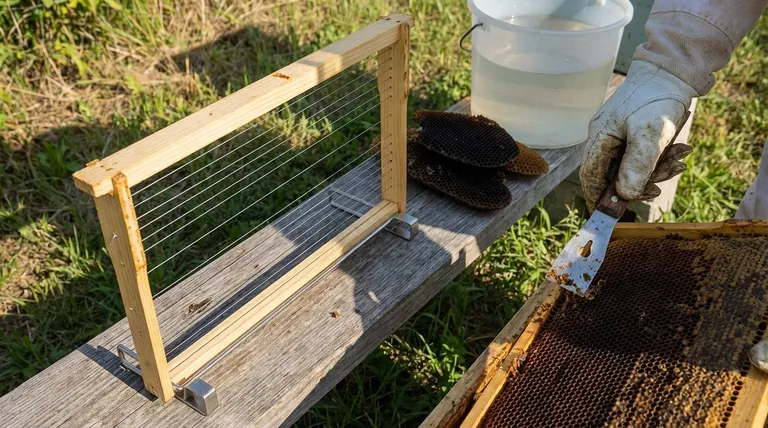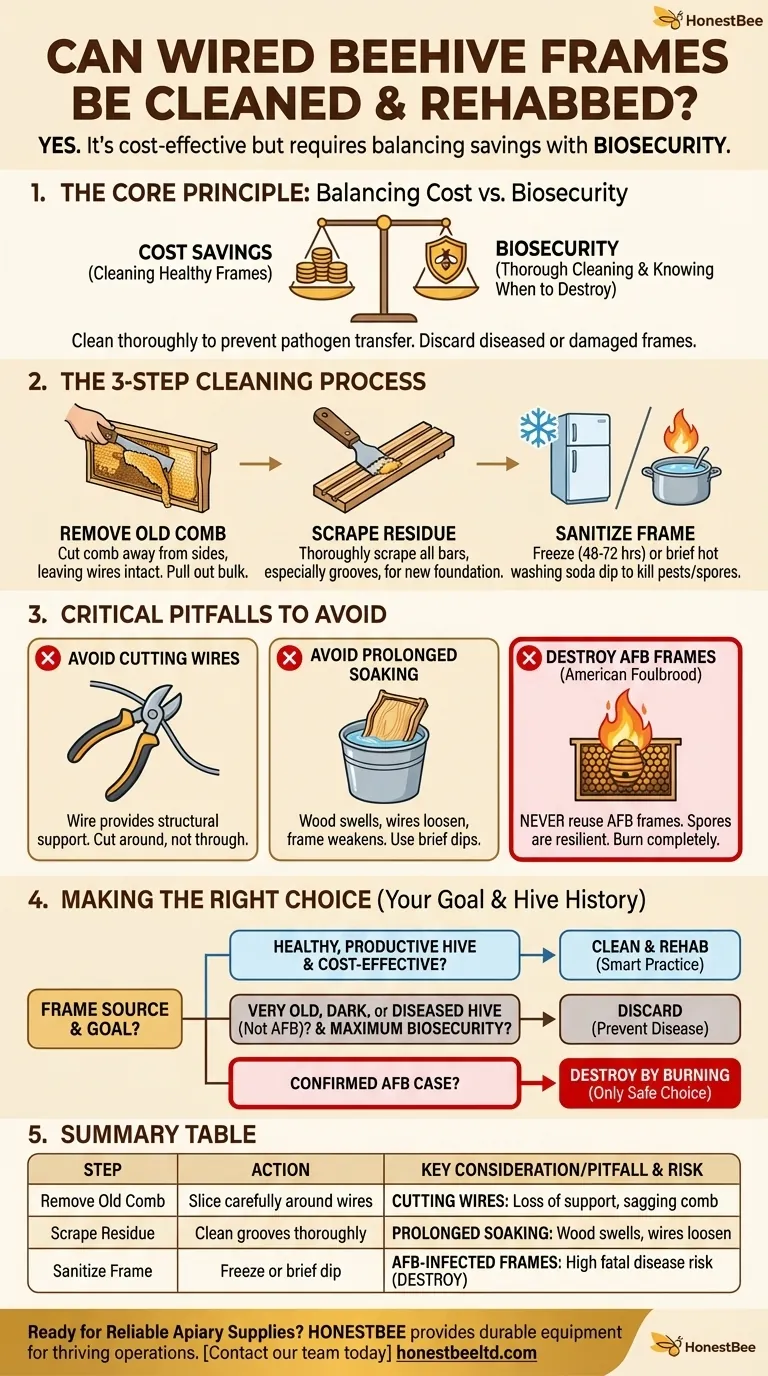Yes, you can absolutely clean and rehab wired beehive frames. This is a common and cost-effective practice for beekeepers. The process involves carefully removing the old comb without cutting the wires, and then sanitizing the wooden frame itself before installing a new sheet of foundation.
The core principle of rehabbing wired frames is balancing cost savings with biosecurity. While cleaning is straightforward, it must be done thoroughly to prevent the transfer of pathogens, and you must know when a frame is too diseased or damaged to be salvaged.

The Process for Cleaning Wired Frames
Rehabilitating a frame is a two-part process: removing the old comb and sanitizing the wood. Doing this correctly preserves the frame's integrity for future use.
Step 1: Remove the Old Comb
The first step is to get the frame back to its basic wood-and-wire state.
Use a sharp hive tool or a sturdy knife to cut the old comb away from the four sides of the wooden frame. Be careful to slice between the wood and the comb, leaving the wires intact. Once the edges are free, you can pull the bulk of the comb and old cocoons out.
Step 2: Scrape Away Residue
After the main comb is gone, the frame will still have propolis and leftover bits of wax.
Use your hive tool to thoroughly scrape all four wooden bars. Pay special attention to the grooves in the top and bottom bars. A clean surface is essential for seating the new foundation properly.
Step 3: Sanitize the Frame
This is the most critical step for bee health. You need to eliminate any lingering pests or disease spores.
The safest and most common methods are freezing or a brief soak. Placing frames in a deep freezer for 48-72 hours will kill wax moth eggs and larvae, as well as some pathogens like chalkbrood. Alternatively, a quick dip in a hot washing soda (sodium carbonate) solution can help sterilize the wood.
Critical Pitfalls to Avoid
While the process is simple, a few key mistakes can damage your equipment or harm your bees. Understanding these trade-offs is crucial.
Avoid Cutting the Wires
The wires provide essential support for the new wax foundation. If you accidentally cut them, the frame loses its structural advantage, leading to sagging or misshapen comb. Always cut around the wires, not through them.
Avoid Prolonged Soaking
Water is the enemy of wooden beehive components. Soaking a frame for an extended period will cause the wood to swell and weaken.
More importantly, it can cause the wood to lose its grip on the wires, resulting in a loss of tension. Loose wires cannot support foundation effectively, defeating the purpose of the frame.
Know When to Destroy a Frame
This is the most important rule of apiary hygiene. Never reuse frames from a colony that died from American Foulbrood (AFB).
AFB spores are incredibly resilient and can remain viable in old equipment for decades. The only safe way to deal with AFB-infected frames is to burn them completely. Attempting to salvage them creates an enormous risk for your entire apiary.
Making the Right Choice for Your Goal
Deciding whether to clean or discard frames depends on your priorities and the history of the hive they came from.
- If your primary focus is maximum biosecurity: Discard very old, dark frames and any frames from hives that showed signs of significant disease.
- If your primary focus is cost-effectiveness: Cleaning frames from healthy, productive colonies is a smart and sustainable practice.
- If you are dealing with a confirmed case of AFB: Your only responsible choice is to destroy the frames and associated comb by burning them.
Making an informed decision about your equipment is a cornerstone of responsible beekeeping.
Summary Table:
| Step | Action | Key Consideration |
|---|---|---|
| 1 | Remove Old Comb | Slice carefully to avoid cutting the support wires. |
| 2 | Scrape Residue | Clean grooves thoroughly for proper foundation seating. |
| 3 | Sanitize Frame | Freeze or use a washing soda dip to kill pests and pathogens. |
| Pitfall | Risk | Solution |
| Cutting Wires | Loss of structural support, sagging comb. | Cut around wires, not through them. |
| Prolonged Soaking | Wood swells, wires loosen, frame weakens. | Use brief dips or freezing instead. |
| AFB-Infected Frames | High risk of spreading fatal disease. | Destroy by burning; never reuse. |
Ready to equip your apiary with reliable, high-quality supplies?
As a trusted wholesale supplier to commercial apiaries and distributors, HONESTBEE provides the durable equipment you need for a thriving operation. Whether you're rehabbing frames or starting anew, we have the foundation, tools, and hardware to support your success.
Contact our team today to discuss your wholesale needs and discover how we can help your business grow.
Visual Guide

Related Products
- Heavy-Duty Stainless Steel Clip-On Frame Perch
- Assembled Wooden Bee Frames with Beeswax Foundation Ready to Use by HONESTBEE
- Professional Bee Frame Wiring Tool with Integrated Tensioning System by HONESTBEE
- Assembled Wooden Bee Frames with Plastic Foundation for Durability and Convenience by HONESTBEE
- Heavy-Duty Stainless Steel Frame Perch
People Also Ask
- How many frames can the beehive frame perch hold? Organize Your Hive Inspections with Ease
- How many frames can a frame perch hold? Optimize Your Hive Inspections with the Right Tool
- What options are available for the frame perch? Choose Between 1-Piece or 2-Piece Designs
- What are the advantages of using a frame rest for the bees? Achieve Calmer, Safer Hive Inspections
- How does the frame rest benefit the beekeeper during hive inspections? Boost Efficiency & Protect Your Colony



















